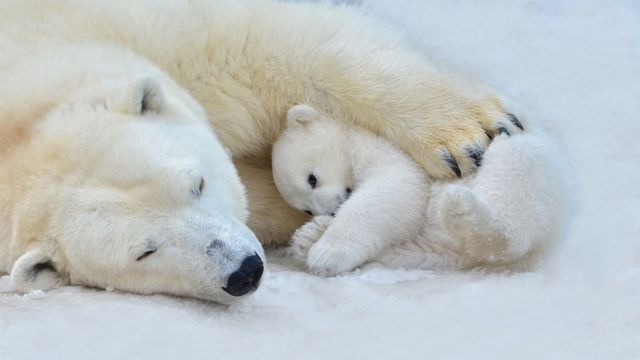In science class, you may have learned about hibernation, where certain animals “sleep” for extended periods during the winter. However, hibernation is a much more intricate process than simply sleeping.
Hibernation is a natural process that allows certain animals to conserve energy and survive harsh conditions or food scarcity, as explained by the Australian Academy of Science. Numerous animals, ranging from chipmunks to woodchucks, undergo hibernation.
Polar bears, are they on that list? Contrary to popular belief, they do not indulge in long winter hibernation like you might assume.
Do polar bears hibernate?
According to Polar Bears International, a conservation nonprofit, polar bears do not undergo true hibernation.
According to the World Animal Protection, when an animal hibernates, its body temperature decreases, its heart rate slows down, and its breathing becomes shallower. As a result, the animal is in a state of being barely conscious and moves very little.
According to the Alaska Department of Fish and Game, bears undergo a period of dormancy during winter, but they are not completely asleep the entire time. While in hibernation, bears reduce their intake of food and water and rarely defecate or urinate.
According to SeaWorld, polar bears do not experience deep hibernation, which means their body temperatures do not decrease significantly, and certain body functions continue.
During the winter months, some carnivores experience a state of lethargy, commonly referred to as “carnivore lethargy.” It’s important to note, however, that not all carnivores exhibit this behavior every winter.
According to SeaWorld, female polar bears, especially those who are pregnant, experience carnivore lethargy. However, the Alaska Department of Fish and Game states that male polar bears and those with cubs tend to remain active even during periods of low food availability.
March Napness, a competition dedicated to rescue bears, aims to dethrone the popular event, March Madness. The goal is to find the ultimate sleep champion among these adorable creatures.
What do polar bears eat?
Polar bears are known to be carnivores, meaning their diet primarily consists of meat. In fact, they are the most carnivorous species within the bear family. To sustain their energy and survival, polar bears require a significant amount of seal fat. According to the World Wide Fund for Nature, these magnificent creatures consume an average of 4.4 pounds of fat per day.
In the Arctic, finding food can be a challenge for polar bears, leading them to go without eating for months. To survive during these periods, polar bears rely on their fat reserves, which play a crucial role in maintaining their overall health. To put it into perspective, a single seal weighing around 121 pounds can provide enough energy to sustain a polar bear for approximately eight days, as reported by the WWF.
Polar bears have a remarkable sense of smell that enables them to locate and consume the remains of larger animals like whales, walruses, and narwhals. Their ability to detect these carcasses allows them to be opportunistic eaters.
Polar bears have a varied diet that includes fish, eggs, kelp, berries, reindeer, rodents, and shellfish.
Polar bears, also known as ‘sea bears,’ primarily inhabit the Arctic region. Let’s explore their natural habitat in the Arctic and learn more about these magnificent creatures.
How much does a polar bear weigh?
According to the Alaska Department of Fish and Game, male polar bears typically weigh between 600 and 1200 pounds. However, there are some exceptional individuals that can reach up to 1700 pounds in weight.
Female polar bears are typically smaller in size, typically weighing between 400 and 700 pounds.
Just Curious for more? We’ve got you covered
USA TODAY is dedicated to answering the questions that you and others ask on a daily basis. Whether you’re wondering about the current tiger population, if cats can eat peanut butter, or what the largest snake in the world is, we’re here to provide you with the answers. Check out our Just Curious section to explore more of the questions we can help you with.
Polar bears are fascinating creatures that inhabit the Arctic region. One question that often arises is whether or not they hibernate. Let’s take a closer look at the sleep behavior of these arctic mammals to understand the truth behind this popular query.



